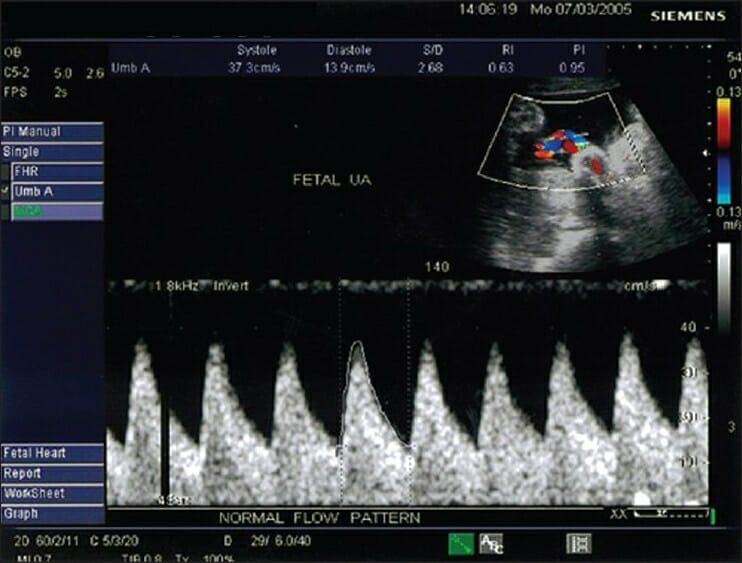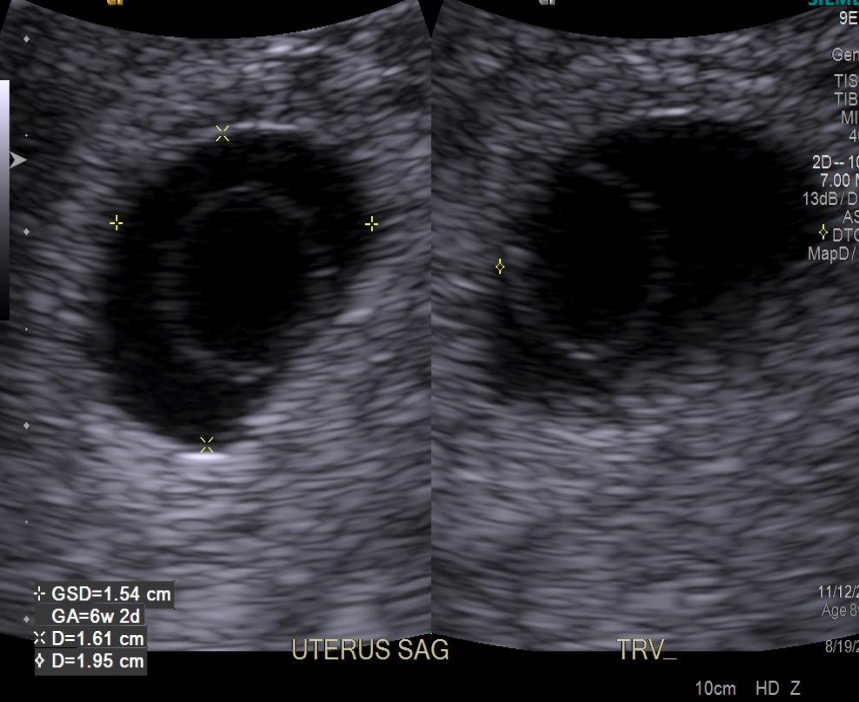Playlist
Show Playlist
Hide Playlist
Antenatal Care: Screening for Down Syndrome (Aneuploidy)
-
Slides ScreeningDownsSyndrome Obstetrics.pdf
-
Download Lecture Overview
00:00 Hi, now we're going to discuss screening for Down syndrome. 00:07 So it's three ways that we screen for Down syndrome in pregnancy. 00:10 We're going to discuss those methods and talk about why we would choose one over the other. 00:14 So the first is the free fetal DNA test. 00:18 Basically, we have found that there is free fetal DNA circulating in mom's blood. 00:23 So mom's blood is drawn, usually after 10 weeks of gestation and you're able to see the actual carrier type of the fetus. 00:30 So you know with a 99% accuracy, if the fetus has Down syndrome. 00:35 You're also able to find out the sex of the baby at that time. 00:39 So the next option for screening is integrated, sequential, or contingency screening. 00:44 These are all grouped the same way. 00:46 But they are performed just a little bit differently. 00:48 And it can be confusing. 00:49 So let's go over that. 00:52 So this test is performed between 11 weeks and 13 weeks and 6 days. 00:56 Has a detection rate of 96%. 00:58 Now the test involves performing a test called the Nuchal Translucency. 01:02 That's an ultrasound that measures the skin fall behind the baby's neck. 01:06 That is done along with blood work, PAPPA and beta-hcg. 01:11 Now the difference in the test. 01:13 So the integrated screening takes the result of that 1st trimester test. 01:17 Again the nuchal translucency and those two hormones PAPPA and beta-hcg. 01:22 And looks at the blood work at the 2nd trimester which is essentially the quad screen, integrates them together, to give a patient's risk of having a fetus with Down syndrome. 01:32 Now this is done as probability so there is no value that's high or low, correct or incorrect. 01:37 Because this is done as probability. 01:40 Sequential screening means that you take the results of the 1st trimester, you get a result. 01:45 You take the results of the 2nd trimester and get a result. 01:50 And overall you're given a result. 01:53 That's a little bit different than the integrated. 01:55 Where with integrated you don't get a result until the 2nd trimester. 01:59 The contingency screen is done in the 1st trimester. 02:03 And if the risk of having Down syndrome is low, the 2nd trimester test is not done. 02:08 Only an alpha-fetoprotein is done in 2nd trimester to determine if there is a risk of nuchal translucency. 02:14 Together these each have a detection rate of about 95 to 96%. 02:19 The 3rd test is the Quad screen. 02:22 This is performed between 15 weeks and 22 weeks and 6 days of gestation. 02:27 Mom's blood is drawn, looking for four different hormone levels. 02:31 That hcg, estriol, inhibin A and alpha fetal protein. 02:35 This has a lowest detection rate, it's 81%. 02:39 And again this is done as probability. 02:41 So it looks at a mother of that ethnicity, at that gestational age with those four hormone levels to tell the probability of the baby having Down syndrome. 02:51 So you can see amongst the three tests, the free fetal DNA is the most accurate. 02:57 However, because it is a little bit newer, it is the most expensive test of the three. 03:02 We do recommend this test for our women that are over 35 years old as they have an increase risk for Down syndrome. 03:09 The Quad screen can be used if a patient enters pregnancy after 13 weeks and 6 days and is not able to get the integrated sequential or contingency screen. 03:23 Now these previous discussed tests are meant for screening purposes only. 03:29 So if they are abnormal then invasive testing is recommended. 03:33 So what are options for invasive testing. 03:36 Well, there's two. 03:37 Chorionic villi sampling and Amniocentesis. 03:40 So Chorionic villi sampling is performed between 10 to 14 weeks of gestational age. 03:45 And as you can see here in the picture, a needle is inserted into mom's belly and there's blood that's drawn from the chorionic villi. 03:51 Carrier type is performed to see if the fetus indeed has Down syndrome. 03:56 The risk of this procedure is pregnancy loss. 03:59 But we are able to do an early gestation. 04:02 The next invasive test is amniocentesis. 04:06 Now with this in a similar manner, as you can see here in the picture, a needle is placed inside mom's belly. 04:13 Amniotic fluid is drawn. 04:15 And again the carrier type is performed. 04:17 This test is usually down around 15 weeks gestational age. 04:20 And again it is confirmation to determine the patient has a fetus with Down syndrome. 04:25 The risk to go along with this procedure are bleeding, infection, placental abruption and again fetal loss. 04:31 It was previously thought that with chorion villi sampling that there was an increased risk of fetal loss compared to amniocentesis. 04:38 But now we know that the risk is about the same. 04:42 So let's go through a study here. 04:45 A 24 year old gravida 1 para 0 female at 8 weeks and 3 days of gestation, presents for an antenatal visit. 04:53 She has a sister with Down syndrome. 04:55 And is concerned that the baby may be at increased risk. 04:58 The best non-invasive screening option for this patient is: A. Free fetal DNA. 05:05 B. Integrated screening. 05:07 C. Quad screen. 05:09 or D. Amniocentesis. 05:11 Well, let's think about this options. 05:13 The free fetal DNA, we've already said, has a 99% detection rate for Down syndrome. 05:19 Integrated screening has about a 95%. 05:21 And then Quad screen has about an 81%. 05:25 Amniocentesis is the most accurate, because it is looking at the carrier type and it is the test for diagnosing Down syndrome. 05:32 But we have to go back to the stem of our question. 05:34 Amniocentesis is not a non-invasive test. 05:38 So based on our options, the answers is A. 05:41 The Free fetal DNA test.
About the Lecture
The lecture Antenatal Care: Screening for Down Syndrome (Aneuploidy) by Veronica Gillispie, MD, MAS, FACOG is from the course Antenatal Care. It contains the following chapters:
- Screening for Down’s Syndrome
- Diagnosis of Down’s Syndrome
Included Quiz Questions
Which of the following is the most accurate, non-invasive screening test for aneuploidy?
- Free fetal DNA test
- Amniocentesis
- Integrated screening
- Quad screening
- Contingency screening
Which of the following tests is done in the first trimester to screen for Down syndrome?
- Nuchal translucency evaluation by ultrasound
- Testing of amniotic fluid
- A measure of maternal alpha-fetoprotein level
- A measure of maternal inhibin A level
- A measure of maternal estriol level
Which of the following tests is done in the second trimester, after 14 weeks' gestation, to confirm fetal Down syndrome?
- Amniocentesis
- Chorionic villi sampling
- Free fetal DNA testing
- Maternal PAPPA levels
- Fetal alpha fetoprotein levels
A 28-year-old G1P0 woman enters prenatal care at 16 weeks gestational age with no other risk factors. In the United States, which is her best choice for fetal aneuploidy screening?
- Quad screening
- Nuchal translucency by ultrasound
- Integrated screening
- Contingency screening
- Chorionic villi karyotyping
Which of the following tests is not part of quad screening?
- Maternal PAPPA level
- Maternal HCG level
- Maternal inhibin A level
- Maternal alpha-fetoprotein level
- Maternal estriol level
A healthy 36-year-old G3P2 woman at a gestational age of 10 weeks and 3 days presents to your clinic for routine prenatal care. She has no other risk factors and no prior problems with pregnancy. Her two other children are healthy and well. Which of the following tests is the best screening tool for fetal Down syndrome for this woman?
- Free fetal DNA test
- Integrated screen
- Quad screen
- She is at high risk given her age over 35, so chorionic villi or amniocentesis karyotyping is recommended.
- Sequential screen
Customer reviews
5,0 of 5 stars
| 5 Stars |
|
1 |
| 4 Stars |
|
0 |
| 3 Stars |
|
0 |
| 2 Stars |
|
0 |
| 1 Star |
|
0 |
Finally I am able to understand these confusing test for Down syndrome!






